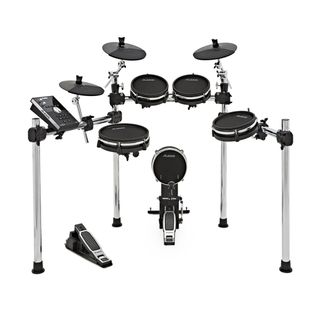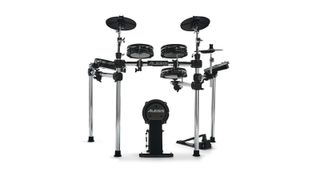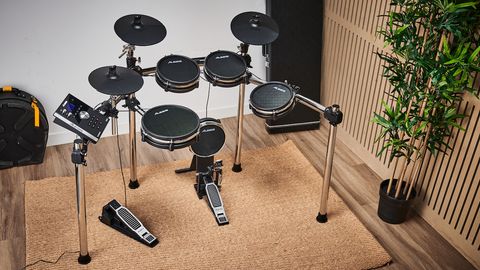When we used to talk about the electronic drum set market it was always a two-horse race between Japanese giants Yamaha and Roland. Those were the names that sprang to the minds of many potential e-kit customers.
But that has all changed in the last decade. The market for electronic drums is now a battleground – particularly at the entry level and mid-priced price points. There is no shortage of very decent options going for competitive prices. It is in this environment that Alesis has made a name for itself. Alesis offers more than just ‘me too’ products; it's now quite possibly the third name that comes to the minds of our potential e-kit customers.
It's no surprise. Alesis has a pedigree that has been proven time and time again in affordable electronic music gear such as the 3630 compressor and the R16 drum machine, to name a couple. It was inevitable it would get around to electronic electronic drums too.
The Command kit with its upgraded designed mesh pads promises an enhanced playing experience. Let's hit it with a stick...
- Explore more of the best Alesis electronic drum sets
- Need that name? Take a look at the best Roland electronic drum sets
Build
The Command is one of three kits in the Alesis line-up that features all-mesh pads, joining the Surge and Alesis’ flagship offering, the Strike. The Command Mesh follows a standard five-piece- plus-cymbals kit configuration. You've got a trio of 8" tom pads, one 10" snare pad and an 8" bass drum pad that similarly uses a mesh head.
Thanks to the snare and tom pads' dual-zone design, separate sounds can be assigned to the head and rim of each pad. Do the math and you get up to eight different voices from these pads alone. Elsewhere, there are three 10" cymbal pads (ride, crash and hi-hats), a hi-hat controller pedal and a bass drum pedal. The sturdy 1 1⁄2" tube rack system is not unlike those on Roland and Yamaha kits.
The Command Mesh has a USB MIDI connection that makes recording MIDI data down to a computer a breeze – and there are standard MIDI in/out sockets, 3.5mm headphone and auxiliary input jacks. If you want to expand the kit, you'll find pad inputs for an additional tom and cymbal pad.
There is another USB socket that is located on the side of the module for uploading jam tracks and samples via an external source.
Sounds

The rack for the kit in a ‘flat pack’ style. You know the drill; the first job is to build it. It's not much fun but there's no workaround – at least it is made easy by a photographic guide. You might have to remind yourself that this is a mid-priced outfit when you see the Command module; it certainly sets itself apart from the competition.
The large rotary control in the middle is central to controlling everything, and, as expected, cycling through the preset kits is a piece of cake. Delving deeper for some heavy editing and new sounds always requires a bit more mashing of the menu and cursors. Select each voice in the kit by hitting the relevant playing surface then adjusting parameters – volume, decay time, pitch, reverb etc – to your liking.
The display could look better. We've seen others with simpler navigation, but once you get the hang of tapping through the options it's no big deal. The sounds are solid and safe, with everything you need. Your choice of acoustic kits includes studio all-rounders to some sophisticated samples of brushed jazz kits – and there are rock, funk and ‘power’ style sounds in there, too.

On the electro side, you've got all the usual suspects – snappy snares, hand claps, 808 kicks and Simmons-style toms... The Command is loaded with percussion. Surprisingly, there is a very respectable amount of tuned percussion, which works out very playable by virtue of playing surfaces equipped with dual-zone sensors.
With a little configuring you can tease pretty much every kind of sound you need out of the raw samples – this will handle all playing styles.
Either connect your phone or device to the 3.5mm aux input, or plug in a USB memory stick. Remember, the USB feature allows you to import samples and assign them to a pad. There are so many possibilities here.
Now, a few caveats. The manual says this works with a USB stick ranging from 4-64GB (weirdly, our 2GB drive worked fine), but it must be formatted to DOS Fat 32 (easily done). Also, samples must be in wav format; they also must also be mono, so there might well be some editing involved if you want to get your sounds to work.
Once you have all your sample ducks in a row, place your USB stick into the module. This creates a set of folders, and so long as the sounds you intend to trigger are placed correctly in the ‘Samples’ folder, you'll be able to view them on the module’s screen when browsing the menu.
Simply select the file, import it into the module, then scroll on back to the beginning of the sound list and assign it to the pad. If this sounds fiddly, it's really just a matter of making sure your sample is formatted correctly. In use, it’s a lot of fun; indeed, the Command could well serve as a useful hybrid brain for the stage as well as the home or practice space.
This is a reasonably-priced kit, providing a whole heap of functionality and features that are ready to use out the box, so naturally it is going to have some limitations. The hi-hat control, for instance, it feels springier and has a boxier look and feel to our Roland model. With a little adjustment, the travel was fixed and it was easy enough to get it operating normally.
What is nice to see is the inclusion of a 'proper' bass drum pad and a sturdy pedal. We've grown accustomed to space/noise-saving triggers so this is a positive step for first-time e-kit players. The mounting hardware did move a little under heavy strikes, so you've got to make sure to tighten it hard. Other bugbears include the rubber rim shrouds, which make tuning with the key a fiddle.
But there is not much to complain about. And definitely nothing that's going to get in the way of you enjoying the kit. Point yourself to your favourite online retailer and you'll find a glut of electronic kits at this price range but none boast this level of features. All mesh heads? This is a big deal.
Sure we would have loved dual-zone cymbal pads, especially when it came to developing ride voicings, but you can't have everything at this price. Besides, it doesn't feel like anything has been compromised on what is a solid set of sounds on a very competitive package.
MusicRadar verdict: Alesis has outdone itself with the Command Mesh. It would be a great option for the pads alone but when allied to its wide range of sounds, sample playback option and so forth... Well, this is a kit that you'll take a long time to outgrow.



